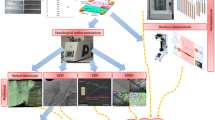Abstract
The welding technology of weave bead welding (WBW) and multi-layer multi-pass welding (MLMPW) are considered to offer advantages over fusion welding in terms of thick plate. The present paper employs a 19.05-mm thick Invar steel plate as the research object to compare the quality of welded joints using WBW and MLMPW. A temperature field model of WBW is established using finite element method; transient temperature field and welding thermal cycle curves of WBW are compared with the ones of MLMPW, which indicates that the characteristic of WBW molten pool periodically changes over time and its temperature distribution is uneven. Moreover, the examinations and analyses of macro/microstructures of WBW and MLMPW are conducted. The results indicate that the inter-layer of Invar steel using WBW is fused better than the one using MLMPW. Perfect weld seam with no defects and a grain growth mechanism of epitaxial solidification of WBW are clearly exposed. The width of heat affected zone (HAZ) using WBW is roughly narrower than that of MLMPW. In addition, the tensile test is conducted to demonstrate that the WBW welded joint has the higher quality.
Similar content being viewed by others
References
Ohnishi T, Kawahito Y, Mizutani M, Katayama S (2013) Butt welding of thick, high strength steel plate with a high power laser and hot wire to improve tolerance to gap variance and control weld metal oxygen content[J]. Sci Technol Weld Join 18(4):314–322
Hashemi SH (2011) Strength–hardness statistical correlation in API X65 steel[J]. Mater Sci Eng A 528(3):1648–1655
Gomez M, Valles P, Medina SF (2011) Evolution of microstructure and precipitation state during thermomechanical processing of a X80 microalloyed steel [J]. Mater Sci Eng A 528(13):4761–4773
Shan S, Zhou CL (2005) Robot application in multi-pass welding [J]. Manuf Autom 1:12–14
Rusinek A, Klepaczko JR (2009) Experiments on heat generated during plastic deformation and stored energy for TRIP steels [J]. Mater Des 30(1):1748–1761
Show BK, Veerababu R, Balamuralikrishnan R, Malakondaiah G (2010) Effect of vanadium and titanium modification on the microstructure and mechanical properties of a microalloyed HSLA steel. Mater Sci Eng A 527(6):1595–1604
Zhang FJ (2000) The development of narrow gap welding [J]. Weld Technol 29(6):33–36
Hu CY, Zhang FJ (2001) Narrow gap welding technology and economical characters analysis [J]. Weld Technol 30(2):47–48
Xu WH, Fan CL, Lin SB, Yang CL (2015) Influence of welding parameters on weld formation in narrow gap of swing arc welding [J]. Weld 02:13–17
Kang YH, Na SJ (2003) Narrow groove gas metal arc welding using electromagnetic arc oscillation [J]. Weld J 82(5):93–99
Hu JF, Yang JG, Fang HY, Li GM, Zhang Y (2006) Numerical simulation on temperature and stress fields of welding with weaving [J]. Sci Technol Weld Join 11(3):358–362
Biradar NS, Raman R (2012) Grain refinement in Al-Mg-Si alloy TIG welds using transverse mechanical arc oscillation [J]. J Mater Eng Perform 21(11):2495–2498
Zhao Y, Sato YS, Kokawa H, Wu AP (2011) Microstructure and properties of friction stir welded high strength Fe-36wt.% Ni alloy[J]. Mater Sci Eng A 528(25–26):7768–7773
Jasthi BK, Arbegast WJ, Howard SM (2009) Thermal expansion coefficient and mechanical properties of friction stir welded invar (Fe-36%Ni)[J]. J Mater Eng Perform 18(7):925–934
Park NJ, Oh MH, Kim SM (2007) Effects of texture on the etching property of Fe-36%Ni invar sheets[J]. Met Mater 6(1):51–56
Zhang J M (2013) Welding process optimization of civil aircraft composite structure with Invar steel[D]. Harbin Institute of Technology
Kiran DV, Basu B, De A (2012) Influence of process variables on weld bead quality in two wire tandem submerged arc welding of HSLA steel[J]. J Mater Process Technol 212(10):2041–2050
Elmesalamy AS, Li L, Francis JA, Sezer HK (2013) Understanding the process parameter interactions in multiple-pass ultra-narrow-gap laser welding of thick-section stainless steels [J]. Int J Adv Manuf Technol 68(1–4):1–17
Yu YC, Yang SL, Yin Y, Wang CM, Hu XY, Meng XX, Yu SF (2013) Multi-pass laser welding of thick plate with filler wire by using a narrow gap joint configuration [J]. J Mech Sci Technol 27(7):2125–2131
Yu L (2007) Numerical simulation of TIG welding process of TA15 titanium alloy[D]. Harbin Institute of Technology
Author information
Authors and Affiliations
Corresponding author
Rights and permissions
About this article
Cite this article
Zhan, X., Zhang, D., Liu, X. et al. Comparison between weave bead welding and multi-layer multi-pass welding for thick plate Invar steel. Int J Adv Manuf Technol 88, 2211–2225 (2017). https://doi.org/10.1007/s00170-016-8926-4
Received:
Accepted:
Published:
Issue Date:
DOI: https://doi.org/10.1007/s00170-016-8926-4




